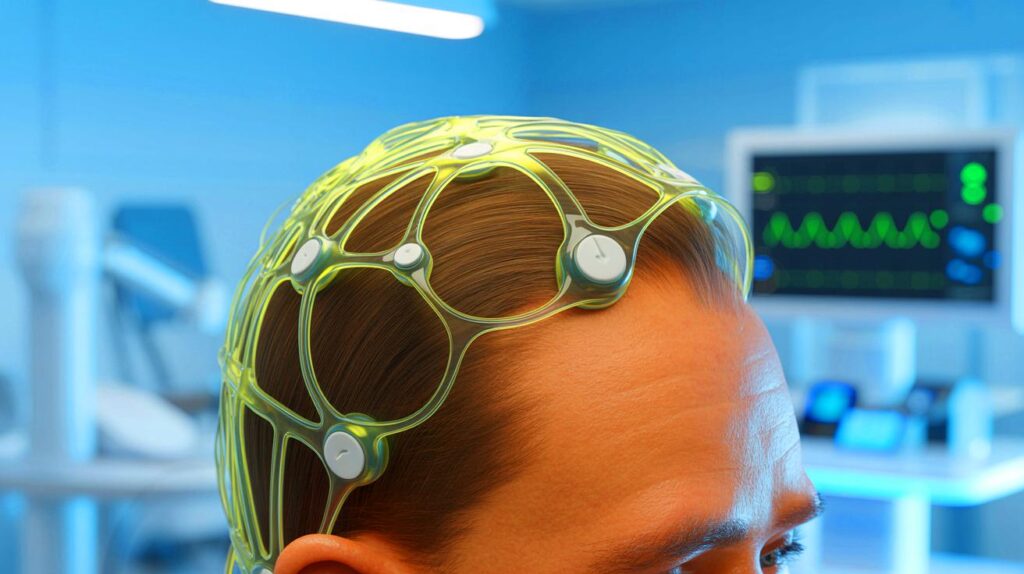| In Brief |
|
Technological advancements in brain monitoring continue to impress with their ingenuity and potential to improve healthcare. One of the latest promising developments is a tiny EEG device designed by researchers at Pennsylvania State University. This device, made from 3D-printed hydrogel, stands out because of its lightness and flexibility, allowing for stable attachment even during everyday movements like brushing one’s hair. This innovation could revolutionize the way we monitor brain functions, providing high-quality recordings while minimizing discomfort for users.
A Miniature Brain Monitor for Reliable Long-Term Data
The miniature EEG device designed by the Penn State team has demonstrated its ability to maintain stable performance for over 24 hours of continuous wear. This technology, detailed in a study published in the journal npj Biomedical Innovations, could revolutionize not only clinical settings but also health and wellness products for consumers. According to Tao Zhou, a professor of engineering and the study’s lead author, the new electrode enables more consistent and reliable monitoring of EEG signals while being nearly imperceptible when worn, thus improving both functionality and patient comfort.
Traditional EEG systems, on the other hand, are often bulky and messy. To precisely record brain activity, electrodes must fit snugly against the scalp, but hair or skin can create gaps that prevent clear signals. To ensure adequate contact, gels are applied, which can irritate the skin. Conventional electrodes are also rigid and may shift during head movements, affecting data coherence.
Innovative Materials for Better Adherence
In response to the limitations of traditional EEG electrodes, Zhou and his team designed a small device resembling a hair made from 3D-printed hydrogel. The electrode, a small dot, captures brain signals from the scalp, while a thin, wire-like component connects it to the monitoring system. This device uses a bioadhesive ink that can be 3D-printed, allowing the electrode to adhere directly to the scalp, thereby eliminating the need for messy gels or skin preparation, which enhances signal quality.
Its lightweight, flexible, and stretchable design ensures it remains in place, even during activities like hairstyling or wearing a cap, making it ideal for prolonged use and chronic monitoring. The new hair-like electrode has demonstrated performance comparable to standard gold electrodes while providing better skin contact and maintaining reliable signal quality for over 24 hours of continuous wear. Unlike traditional EEG systems, the electrode does not need to be replaced, ensuring consistent data over multiple monitoring sessions.
Toward Increased Mobility with Wireless Technology
Currently, the EEG device requires a wired connection, forcing patients to remain tethered to a machine, which limits their mobility. However, researchers at Penn State are working to make this system wireless in the future, allowing for greater freedom of movement during recordings. This advancement could pave the way for broader and more practical use of EEG monitoring in daily life and non-clinical environments.
The shift to a wireless device would represent a significant improvement, not only in terms of comfort but also in accessibility for users. By making EEG monitoring more convenient and less invasive, this technology could become the standard for monitoring brain health, facilitating early detection and management of neurological disorders.
Potential Impact on the Health and Wellness Market
The innovation from Penn State aligns with a broader trend towards smarter, more comfortable medical devices. By making EEG monitoring more accessible and less invasive, this technology could transform the health and wellness market. The implications extend beyond clinical care, affecting consumer products that could benefit from integrated brain monitoring to enhance overall well-being.
Such innovations raise questions about the integration of technology into our daily lives for proactive health management. How will this technology influence our health and wellness habits in the future?







